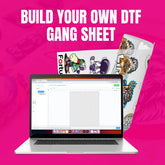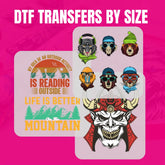Heat Transfers vs. DTF Transfers: What Works Best?
Two techniques really stand out in fabric printing: DTF transfers and heat transfers. Both have special advantages, but the one you choose will rely on your particular requirements. Although heat transfers have long been a go-to choice, DTF transfers have become rather popular because of their excellent printing and adaptability. Knowing the variations will enable you to choose the most durable print or launch a bespoke clothing company with educated knowledge.
How Do Heat Transfers Work?
Heat transfers apply designs to cloth using heat and pressure. This technique cuts a vinyl design, fits it on a garment, and then presses it with a heat press. The heat activates the adhesive backing, binding the design to the fabric. Simple designs, names, and sports jerseys' numbers follow heat transfers.
Heat transfers have one main benefit: they are easily available. Starting requires no costly tools; you just need a basic vinyl cutter and heat press equipment. Custom prints can be produced from a basic vinyl cutter and heat press equipment. However, the procedure takes time, particularly for intricate or multicolored designs, as each color must be laid separately.
What Makes DTF Transfers Different?
A more recent and sophisticated approach is DTF transfers, sometimes known as direct-to-film transfers. DTF transfer sheets are produced straight onto a film. The pattern is then cured, covered in an adhesive powder, and heated press-on onto the cloth. This approach lets one create full-color, high-resolution designs without weeding or layering.
DTF transfers provide more versatility and work on practically any fabric, including cotton, polyester, and blends. Custom DTF transfers stick nicely to various materials, but traditional heat transfers find difficulty with polyester and flexible fabrics. Perfect for commercial use, they also offer vivid colors and improved durability.
How Do Durability and Washability Compare?
When deciding between DTF and heat transfers, durability is the main factor. Particularly vinyl-based heat transfers can peel or break with time, especially following several washes. Early wear and tear results from vinyl's adhesive not always bonding tightly with fabric.
Conversely, DTF heat transfers are meant to last. DTF transfer sheets' ink links directly with fabric fibers, resisting fading and cracking. Studies reveal that DTF prints resist over 50 washes without appreciable degradation. For companies trying to create durable, premium clothing, this makes them a preferred choice.
Which Method is More Cost-Effective?
DTF transfers and heat transfers differ mostly in cost, which determines which is preferred. Since they require little equipment, heat transfers are more financially sensible initially. For small-scale projects or amateurs, a vinyl cutter and heat press are sufficient to start and make this choice perfect.
Nevertheless, custom DTF transfers become more affordable when manufacturing large batches. Although the initial outlay in a DTF transfer printer and materials is higher, the ability to print intricate, full-color graphics in one step lowers labor costs and manufacturing time. Over time, this efficiency might help companies increase their profit margins.
Which Printing Method is Easier to Use?
Heat transfers are easier for novices. Design, cutting, and pressing are part of the procedure, which requires little technical understanding. DTF heat transfers are the superior choice, nonetheless, for companies trying to manufacture faster. DTF printing greatly accelerates the process since there is no need for layering or weeding several colors.
Conclusion: Which Transfer Method Should You Choose?
DTF and heat transfers have benefits. Heat transfers could be ideal for your simple project or distinctive design. Custom DTF transfers are the best option, though, if you want excellent, long-lasting prints that can manage intricate graphics. Whether you're a small business or a large production shop, DTF transfer sheets provide versatility, durability, and vibrant color quality. To explore high-quality DTF heat transfers, visit DTF Transfer Art today.
- Blended fabrics for DTF
- bulk dtf transfers
- bulk printing
- cost-efficient printing
- Cotton for DTF
- Custom apparel
- custom apparel printing
- Custom clothing printing
- custom gangsheet
- Custom gangsheet DTF transfer sheets
- Custom gangsheet printing
- Custom Gangsheets
- custom heat transfers
- Custom iron patches
- custom prints
- decal production
- decal transfer
- decal transfers
- Design preparation
- Digital printing
- Direct-to-Film Transfer
- dtf business
- DTF gangsheet
- DTF Heat Press
- dtf print shop
- DTF printer supplier
- DTF Printing
- dtf transfer
- dtf transfer art
- dtf transfer film
- dtf transfer instructions
- dtf transfer paper
- DTF transfer paper suppliers
- dtf transfer printer
- dtf transfer sheets
- DTF transfer supplier
- DTF transfer wholesale
- dtf transfers
- dtf transfers near me
- dtf transfers ready to press
- dtf transfers wholesale
- DTF vs Screen Printing
- DTF vs Vinyl
- DTF vs. iron-on
- dtf wholesale
- Fabric type (cotton
- gangsheet printing
- heat press printing
- Heat press settings
- Heat settings for DTF
- heat transfer decals
- heat transfer method
- heat transfer printing
- Heat transfers
- hoodie printing
- Hoodies
- hot peel DTF
- iron-on decals
- Jerseys
- Leather DTF transfers
- Local print shops
- Mild detergent for DTF prints
- model decals
- Nylon DTF transfer
- Peeling or cracking prevention
- polyester
- Polyester for DTF
- premium DTF transfers
- print on demand
- Print shops near me
- Printed designs durability
- Printing companies
- Printing methods
- Quality printing
- reliable DTF transfer printer supplier
- Screen printing
- Spandex DTF transfer
- Sublimation printing
- t shirt printing
- T-shirts
- Tote bags
- Transfer printing
- trustworthy DTF transfer supplier
- vinyl decals
- Washing care for DTF prints
- what is dtf transfer






